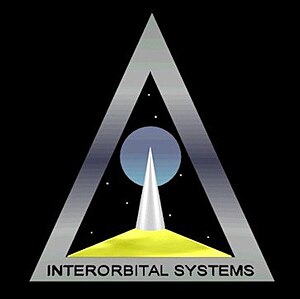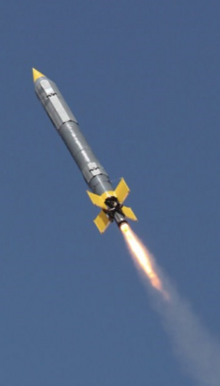
Spaceflight is an application of astronautics to fly objects, usually spacecraft, into or through outer space, either with or without humans on board. Most spaceflight is uncrewed and conducted mainly with spacecraft such as satellites in orbit around Earth, but also includes space probes for flights beyond Earth orbit. Such spaceflight operate either by telerobotic or autonomous control. The more complex human spaceflight has been pursued soon after the first orbital satellites and has reached the Moon and permanent human presence in space around Earth, particularly with the use of space stations. Human spaceflight programs include the Soyuz, Shenzhou, the past Apollo Moon landing and the Space Shuttle programs. Other current spaceflight are conducted to the International Space Station and to China's Tiangong Space Station.

The Polar Satellite Launch Vehicle (PSLV) is an expendable medium-lift launch vehicle designed and operated by the Indian Space Research Organisation (ISRO). It was developed to allow India to launch its Indian Remote Sensing (IRS) satellites into Sun-synchronous orbits, a service that was, until the advent of the PSLV in 1993, only commercially available from Russia. PSLV can also launch small size satellites into Geostationary Transfer Orbit (GTO).

Armadillo Aerospace was an aerospace startup company based in Mesquite, Texas. Its initial goal was to build a crewed suborbital spacecraft capable of space tourism, and it had also stated long-term ambitions of orbital spaceflight. The company was founded by John Carmack, co-founder and former chief technical officer of id Software.
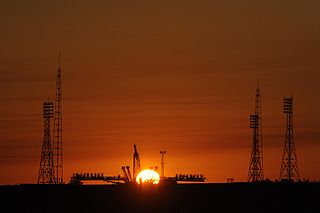
A spaceport or cosmodrome is a site for launching or receiving spacecraft, by analogy to a seaport for ships or an airport for aircraft. The word spaceport, and even more so cosmodrome, has traditionally been used for sites capable of launching spacecraft into orbit around Earth or on interplanetary trajectories. However, rocket launch sites for purely sub-orbital flights are sometimes called spaceports, as in recent years new and proposed sites for suborbital human flights have been frequently referred to or named "spaceports". Space stations and proposed future bases on the Moon are sometimes called spaceports, in particular if intended as a base for further journeys.

The Canadian Arrow was a privately funded, early-2000s rocket and space tourism project concept founded by London, Ontario, Canada entrepreneurs Geoff Sheerin, Dan McKibbon and Chris Corke. The project's objective was to take the first civilians into space, on a vertical sub-orbital spaceflight reaching an altitude of 112 km.
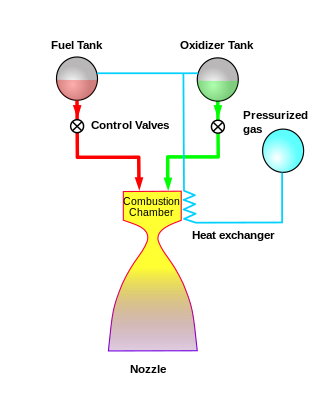
The pressure-fed engine is a class of rocket engine designs. A separate gas supply, usually helium, pressurizes the propellant tanks to force fuel and oxidizer to the combustion chamber. To maintain adequate flow, the tank pressures must exceed the combustion chamber pressure.
Micro-Space was an aerospace corporation based in Denver, Colorado, founded in February 1977 by Richard P. Speck under the name Spectron Instrument Corporation. The corporation changed its name to "Micro-Space, Inc." in 1998. It was dissolved in 2011, following the death of the founder.

Masten Space Systems was an aerospace manufacturer startup company in Mojave, California that was developing a line of vertical takeoff, vertical landing (VTVL) rockets, initially for uncrewed research sub-orbital spaceflights and eventually intended to support robotic orbital spaceflight launches.
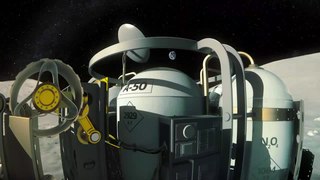
The Google Lunar X Prize (GLXP) was a 2007–2018 inducement prize space competition organized by the X Prize Foundation, and sponsored by Google. The challenge called for privately funded teams to be the first to land a lunar rover on the Moon, travel 500 meters, and transmit back to Earth high-definition video and images.
Moon Express is an American privately held company formed in 2010 by a group of Silicon Valley and space entrepreneurs. It had the goal of winning the $30 million Google Lunar X Prize, and of ultimately mining the Moon for natural resources of economic value. The company was not able to make a launch attempt to reach the Moon by March 31, 2018, the deadline for the prize.
The Rocket City Space Pioneers (RCSP) was one of 29 teams from 17 different countries officially registered and in the competition for the Google Lunar X PRIZE (GLXP) during 2010–2012.
SpaceMETA is a Brazilian Group founded in 2010 to explore aerospace opportunities motivated by Google Lunar XPrize Competition.
TeamIndus is a private for-profit aerospace company headquartered in Bangalore, India. It consists of a team of professionals from various backgrounds in science, technology, finance, and media, that came together in 2010 with the aim of winning the Google Lunar X Prize competition announced in 2007. Although the competition ended in 2018 without a winner, TeamIndus is still working towards developing and launching their lunar rover mission sometime in 2020 after partnering with OrbitBeyond.

SpaceIL is an Israeli organization, established in 2011, that competed in the Google Lunar X Prize (GLXP) contest to land a spacecraft on the Moon.

Synergy Moon is an international commercial enterprise dedicated to the development of space technologies and related services.
Curie is a liquid-propellant rocket engine designed and manufactured by Rocket Lab. A bipropellant is used for the propulsion of the third stage/kick stage of the Electron rocket, as well as the Photon. The composition of the propellant is a trade secret.

The year 2024 is expected to exceed 2023's 223 orbital launches. So far, the year saw the successful first launch of Vulcan Centaur, Gravity-1, and notably the third developmental launch of SpaceX's Starship – IFT-3. Following the 2020s' trend, it is expected to that many more privately-developed launch vehicles will feature a maiden launch in 2024.
OneSpace or One Space Technology Group is a Chinese private space launch group based in Beijing, subsidiaries in Chongqing, Shenzhen and Xi'an. OneSpace was founded in 2015. OneSpace is led by CEO Shu Chang, and is targeting the small launcher market for microsatellites and nanosatellites. OneSpace launched China's first private rocket in 2018.

Starship is a two-stage super heavy lift launch vehicle under development by American aerospace company SpaceX. It is the largest and most powerful rocket ever flown. Starship is intended to be fully reusable, allowing both stages to be recovered after a mission and to be rapidly reused. SpaceX has stated that a long-term goal for the Starship system is to achieve frequent space launches at low cost. Development follows an iterative and incremental approach, involving often destructive test flights of prototype vehicles.
